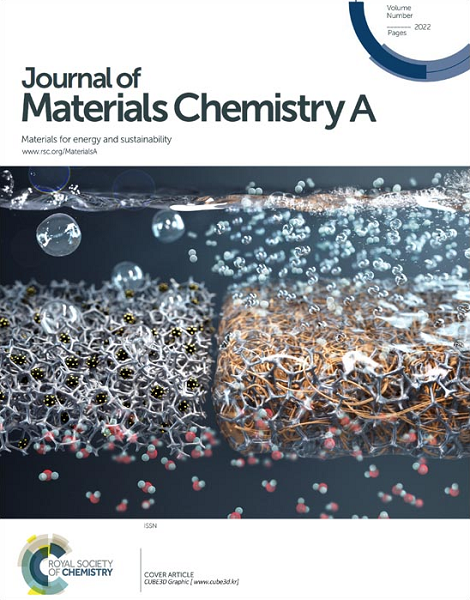Synergistic catalysis at in situ-formed Pt-NiOOH nanodot interfaces for highly efficient ammonia borane hydrolysis
IF 10.7
2区 材料科学
Q1 CHEMISTRY, PHYSICAL
引用次数: 0
Abstract
Hydrolysis of ammonia borane (AB) comprising multiple intermediate steps is a representative catalytic reaction for hydrogen generation, usually requiring noble metal Pt as a catalyst. Constructing heterostructures is an effective strategy to improve the catalytic activity while reducing Pt usage. Herein, tailored nanodot-nanodot heterostructures of Pt-Ni(OH)x on reduced graphene oxide (RGO) are realized by one-step solvothermal method. It is intriguingly found that local NiOOH nanodots, rather than Ni(OH)2, are in situ formed when encountering Pt on RGO, forming the heterointerface. Subsequently, the optimized Pt-Ni(OH)x/RGO catalyst exhibits the highest turnover frequency (TOF) of 17740 min−1 based on the Pt loading for the hydrogen generation from AB hydrolysis at 303 K, which is 28 times as high as that of Pt/RGO. Theoretical calculations reveal that the heterojunction catalyst promotes the chemisorption and dissociation of water molecules, accelerating H2 generation from AB hydrolysis. This one-step solvothermal method to produce the Pt-Ni(OH)x/RGO catalyst provides a general route to high-performance nanodot-nanodot heterostructure catalysts for various hydrogen-generation catalytic domains.由多个中间步骤组成的硼烷氨(AB)水解是一种具有代表性的催化制氢反应,通常需要贵金属铂作为催化剂。构建异质结构是提高催化活性同时减少铂用量的有效策略。本文通过一步溶热法在还原氧化石墨烯(RGO)上实现了量身定制的铂-镍(OH)x 纳米点-纳米点异质结构。有趣的是,在 RGO 上遇到铂时,局部的 NiOOH 纳米点(而不是 Ni(OH)2)会在原位形成,从而形成异质界面。随后,优化后的 Pt-Ni(OH)x/RGO 催化剂在 303 K 条件下进行 AB 水解制氢时,根据铂负载量,显示出最高的周转频率(TOF),达到 17740 min-1,是 Pt/RGO 催化剂的 28 倍。理论计算显示,异质结催化剂促进了水分子的化学吸附和解离,加速了 AB 水解产生 H2。这种一步溶热法制备 Pt-Ni(OH)x/RGO 催化剂为各种氢气生成催化领域的高性能纳米点-纳米点异质结构催化剂提供了一条通用路线。
本文章由计算机程序翻译,如有差异,请以英文原文为准。
求助全文
约1分钟内获得全文
求助全文
来源期刊

Journal of Materials Chemistry A
CHEMISTRY, PHYSICAL-ENERGY & FUELS
CiteScore
19.50
自引率
5.00%
发文量
1892
审稿时长
1.5 months
期刊介绍:
The Journal of Materials Chemistry A, B & C covers a wide range of high-quality studies in the field of materials chemistry, with each section focusing on specific applications of the materials studied. Journal of Materials Chemistry A emphasizes applications in energy and sustainability, including topics such as artificial photosynthesis, batteries, and fuel cells. Journal of Materials Chemistry B focuses on applications in biology and medicine, while Journal of Materials Chemistry C covers applications in optical, magnetic, and electronic devices. Example topic areas within the scope of Journal of Materials Chemistry A include catalysis, green/sustainable materials, sensors, and water treatment, among others.
 求助内容:
求助内容: 应助结果提醒方式:
应助结果提醒方式:


